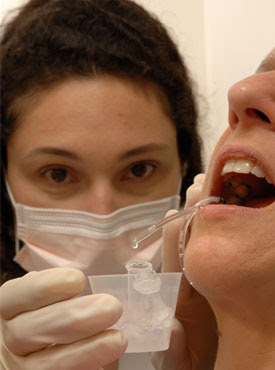Tooth decay detection is done visually, sensed using a probe and also by means of X-rays. There are various tooth decay risk assessment methods and activity tests available like saliva test but are mainly used to educate and motivate individuals to realize the effects of good oral hygiene regimen
. Thorough plaque (the bacterial biofilm on the tooth surface) control still remains the best method of preventing tooth decay.
Saliva test may include:
--------------------------
Snyder Colorimetric Test – your dentist will ask you to chew on a piece of paraffin and the resulting saliva is stored in a sterile bottle. The sample is examined daily for three days and the color changes are recorded. Color changes from green to yellow indicate the amount of pH change which can point to bacterial activity in the mouth.
Salivary Reductase Test – the saliva sample is mixed with a dye and the color change is recorded. It is used to measure the activity of reductase enzyme present in salivary bacteria.
Streptococcus mutans Count – the saliva collected is used to count the colony units of S.mutans, which is one of the main bacteria involved in tooth decay.
Salivary Flow- unstimulated saliva (regular saliva at rest) is first collected and then measured then the test is repeated with a stimulated salivary flow. Results are compared and the salivary flow rate is determined.
Saliva test may include:
--------------------------
Snyder Colorimetric Test – your dentist will ask you to chew on a piece of paraffin and the resulting saliva is stored in a sterile bottle. The sample is examined daily for three days and the color changes are recorded. Color changes from green to yellow indicate the amount of pH change which can point to bacterial activity in the mouth.
Salivary Reductase Test – the saliva sample is mixed with a dye and the color change is recorded. It is used to measure the activity of reductase enzyme present in salivary bacteria.
Streptococcus mutans Count – the saliva collected is used to count the colony units of S.mutans, which is one of the main bacteria involved in tooth decay.
Salivary Flow- unstimulated saliva (regular saliva at rest) is first collected and then measured then the test is repeated with a stimulated salivary flow. Results are compared and the salivary flow rate is determined.
the following can be detected in a saliva test:
--------------------------
Alcohol
Amphetamines
Barbiturates
Benzodiazepines
Caffeine
Cocaine
Inhalants
LSD
Marijuana
Opioids
Phencyclidine (PCP)
Tobacco products
--------------------------
Alcohol
Amphetamines
Barbiturates
Benzodiazepines
Caffeine
Cocaine
Inhalants
LSD
Marijuana
Opioids
Phencyclidine (PCP)
Tobacco products




Hey thanks for this post. It's so helpful that one can know if the person is having a tooth decay with just a saliva test. I faced a lot of dental problems, especially tooth decay. I avoided visiting a dentist and rather searched for natural ways to cure it but it was all in vain. So i decided to see dentist Mumbai and get the treatment done rather than avoid seeing the dentist. I am so glad to take this decision not just that i am relieved of the pain but also have no more fear of seeing the dentist.
ReplyDelete